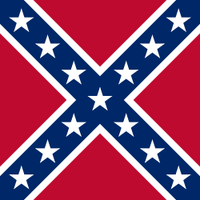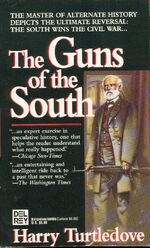
The Battle Flag of the Army of Northern Virginia
The Army of Northern Virginia was the primary military force of the Confederate States of America in the Eastern Theater of the American Civil War, and was the largest Confederate field army in any theater. Established in 1861, it is most closely identified with its third and last commander, General Robert E. Lee. Under Lee, the ANV participated in some of the most famous and most critical battles of the war. It was disbanded in April, 1865, after Lee surrendered to U.S. General Ulysses S. Grant.
Army of Northern Virginia in The Guns of the South
In 1864, The Army of Northern Virginia were supplied with, and trained in the use of, AK-47s by Andries Rhoodie, a time-traveler. Despite the poor state of the C.S. cause in general, the advanced weaponry more than made up the superior numbers of the North. The Army invaded the North, eventually taking Washington City and the White House. Once Abraham Lincoln capitulated, the C.S. was recognized by Britain, and became independent.
Army of Northern Virginia in Southern Victory
The Army of Northern Virginia under Lee defeated and destroyed George McClellan's Union Army of the Potomac at Camp Hill, Pennsylvania. It then advanced on Philadelphia and forced the Union out of the war.
In the Great War, the ANV took Washington, DC then fought its way north into Maryland and Pennsylvania, coming within aeroplane range of Philadelphia before being driven back. Jake Featherston, Clarence Potter, and Jeb Stuart III all served with the army at this time.
In 1941 the Army of Northern Virginia was commanded by General Hank Coomer. Coomer slowed Daniel MacArthur's drive into northern Virginia that year to a crawl, then, with the help of his commander of armored forces, George Patton, halted the advance altogether with the Battles of Fredericksburg the following year.
In 1943, with the Virginia front stabilized, much of the Army of Northern Virginia was transferred to George Patton's command to combat Irving Morrell's rapid advance that year.
| |||||||||||||||||||











